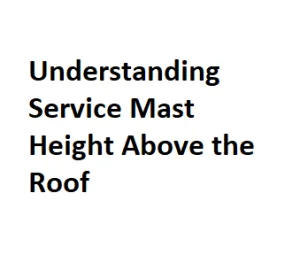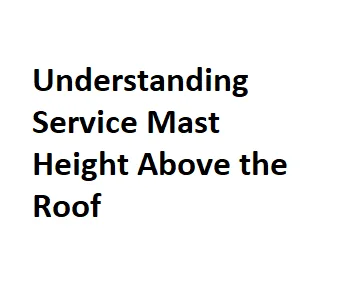When it comes to electrical installations on residential or commercial buildings, one crucial consideration is the height of the service mast above the roof. The service mast, also known as the weatherhead or service entrance cap, plays a vital role in providing a secure and weatherproof connection between the electrical service drop and the building’s wiring. In this blog post, we will explore the significance of service mast height above the roof and the factors that influence its installation.
Importance of Service Mast Height:
The height at which the service mast is installed above the roof is not arbitrary; it is determined by electrical codes and safety standards to ensure the well-being of both the electrical system and the structure it serves. Here are some key reasons why the service mast height above the roof is crucial:
- Clearance Requirements: Electrical codes mandate specific clearance requirements between the service mast and nearby structures, including the roof. Maintaining adequate clearance helps prevent accidental contact with electrical components and reduces the risk of fire hazards.
- Weather Protection: The service mast is designed to provide weather protection for the electrical service drop and wiring. Proper elevation above the roof helps prevent water ingress, ensuring the longevity and reliability of the electrical system.
- Accessibility for Maintenance: Installing the service mast at an appropriate height makes it more accessible for maintenance and repairs. Electricians need to be able to reach and work on the mast safely without compromising their well-being.
Factors Influencing Service Mast Height:
Several factors come into play when determining the appropriate height for the service mast above the roof. These factors include:
- Roof Type: Different roof types may require varying service mast heights. For instance, a flat roof may have different clearance requirements than a sloped roof. Understanding the specific characteristics of the roof is essential in determining the appropriate height.
- Local Building Codes: Building codes and regulations vary by location. It is crucial to consult local electrical codes to ensure compliance with height requirements. Failure to adhere to these codes could result in fines, penalties, or the need for corrective measures.
- Climate Considerations: Regions with harsh weather conditions, such as high winds or heavy snowfall, may have specific guidelines regarding service mast height. Adhering to these recommendations ensures that the electrical system remains resilient in adverse weather conditions.
Tips for Proper Service Mast Installation:
- Consult with a Professional: Before initiating any electrical work, it is advisable to consult with a licensed electrician or electrical contractor. They can provide insights into local regulations, offer guidance on the appropriate height for the service mast, and ensure that the installation meets safety standards.
- Evaluate Roof Characteristics: Take into account the specific characteristics of the roof, including its slope, material, and any potential obstructions. Different roof types may require adjustments in the service mast height to maintain proper clearance and weather protection.
- Weatherproofing Measures: In addition to proper height, ensure that the service mast is adequately weatherproofed. This involves using weather-resistant materials and sealing any openings to prevent water infiltration. A well-sealed service mast contributes to the longevity of the electrical components it houses.
- Regular Inspections: Schedule regular inspections of the service mast to identify any signs of wear, damage, or degradation. Timely maintenance can prevent issues before they escalate, ensuring the continued reliability of the electrical system.
- Stay Informed on Code Changes: Building codes are subject to updates and changes. It is essential for property owners and electricians to stay informed about any revisions to local codes that may impact service mast installations. This proactive approach ensures ongoing compliance and safety.
- Consider Future Modifications: If there are plans for future modifications to the building, such as additions or renovations, take these into account when determining the service mast height. Planning for potential changes can prevent the need for costly adjustments later on.
- Education and Training: Property owners should familiarize themselves with basic electrical safety principles and the specifics of their electrical system. Knowing the fundamentals can empower individuals to make informed decisions and communicate effectively with electricians.
- Documentation: Keep detailed records of the service mast installation, including specifications, date of installation, and any maintenance or repairs performed. This documentation can be valuable for future reference, inspections, or if you decide to sell the property.
- Emergency Preparedness: Know the location of the main electrical disconnect and inform other occupants. In emergencies or when quick power shutdown is necessary, understanding how to access and use the main disconnect is crucial.
- Consider Voltage Drop: When determining the service mast height, especially for longer runs, consider the potential for voltage drop. Voltage drop can impact the efficiency of electrical appliances and devices. Consulting with an electrician can help ensure that the electrical system is designed to minimize voltage drop.
- Upgrading Older Installations: Consider upgrading your older electrical installation to meet current safety standards. This may include adjusting the service mast height and updating wiring, panels, and other components to enhance overall safety and efficiency.
- Community Engagement: In community or neighborhood settings, there may be shared responsibilities for electrical infrastructure. Engage with neighbors or community associations to ensure that collective efforts are made to maintain a safe electrical environment. Collaboration can lead to shared resources, knowledge, and a safer living environment for everyone.
- Training for Maintenance Personnel: If you have on-site personnel responsible for building maintenance, ensure they receive proper training on electrical safety protocols. This includes understanding the significance of the service mast, recognizing potential issues, and knowing when to seek professional assistance.
- Utilize Technology: Embrace technological advancements in electrical systems. Smart monitoring and control systems can provide real-time data on electrical usage, potential faults, and system performance. Integrating these technologies can contribute to proactive maintenance and increased overall system reliability.
Residential Service Masts
| Mast Type |
Material |
Height (feet) |
Code Compliance |
Roof Clearance (feet) |
| Overhead |
Steel |
10 |
NEC 230-24 |
2 |
| Underground |
PVC |
15 |
NEC 230-26 |
N/A |
| Surface Mount |
Aluminum |
12 |
Local Codes |
3 |
| Side Entry |
Galvanized |
8 |
NEC 230-27 |
1.5 |
| Rooftop |
Copper |
20 |
NEC 230-28 |
5 |
Commercial Service Masts
| Mast Type |
Material |
Height (feet) |
Code Compliance |
Roof Clearance (feet) |
| Overhead |
Steel |
20 |
NEC 230-24 |
4 |
| Underground |
PVC |
25 |
NEC 230-26 |
N/A |
| Surface Mount |
Aluminum |
18 |
Local Codes |
6 |
| Side Entry |
Galvanized |
15 |
NEC 230-27 |
3 |
| Rooftop |
Copper |
30 |
NEC 230-28 |
8 |
Industrial Service Masts
| Mast Type |
Material |
Height (feet) |
Code Compliance |
Roof Clearance (feet) |
| Overhead |
Steel |
30 |
NEC 230-24 |
6 |
| Underground |
PVC |
35 |
NEC 230-26 |
N/A |
| Surface Mount |
Aluminum |
28 |
Local Codes |
8 |
| Side Entry |
Galvanized |
25 |
NEC 230-27 |
5 |
| Rooftop |
Copper |
40 |
NEC 230-28 |
10 |
Service Mast Components
| Component |
Purpose |
Material |
Standard Size (inches) |
Installation Depth (inches) |
| Mast Conduit |
Protects Wiring |
PVC |
2 |
18 |
| Weatherhead |
Weather Protection |
Aluminum |
4 |
N/A |
| Service Head |
Connection Point |
Steel |
6 |
N/A |
| Mast Bracket |
Structural Support |
Galvanized Steel |
8 |
N/A |
| Conduit Straps |
Secures Conduit to the Wall |
Stainless Steel |
1 |
N/A |
Service Mast Safety Guidelines
| Guideline |
Description |
| Minimum Clearance from Power Lines |
Maintain a minimum distance as per local regulations. |
| Inspection Frequency |
Regularly inspect for wear, corrosion, and other signs of damage. |
| Lightning Protection |
Consider installing lightning protection for taller service masts. |
| Wind Load Calculations |
Evaluate wind load to ensure structural integrity. |
| Professional Installation |
Always hire qualified electricians for installation and repairs. |
Conclusion:
In the ever-evolving landscape of electrical safety and infrastructure, ongoing attention and commitment to best practices are essential. The service mast’s height above the roof is just one component of a broader electrical system, and its proper installation is integral to the safety and functionality of the entire network.
By adhering to local codes, consulting with professionals, and implementing proactive maintenance measures, property owners can ensure that their electrical systems not only meet safety standards today but remain resilient and adaptable to future needs. Electrical safety is a shared responsibility, and staying informed and proactive in maintaining electrical infrastructure contributes to a safer, more reliable living and working environment for all.


